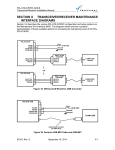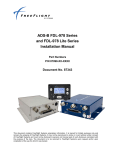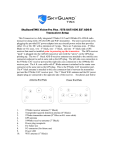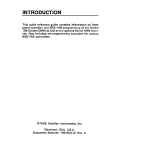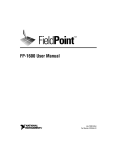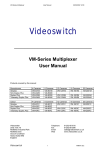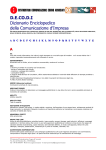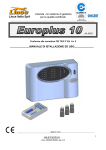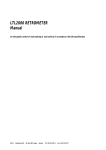Download FDL-978-XVR and FDL-978-RX Installation Manual
Transcript
ADS-B FDL-978 Series and Lite Series Installation Manual Document No. 87343 Rev F 3.1.2.4 Code Knob The CODE knob is used to set Squawk Codes and Call Sign/Flight IDs. The FN button selects which item will be updated. Turning the knob will highlight the first digit on the display, then the digit can be changed as required. Press the ENT button to advance to the next digit. When the ENT button is pressed on the last digit, the new Squawk Code or Call Sign/Flight ID will replace the previous value. If the code entry is not completed within 7 seconds the changes are ignored and the previous code restored. Code Description 1200 VFR Code in the USA 7000 VFR Code commonly used in Europe. 7500 Hijack Code 7600 Loss of communications 7700 Emergency Code The Call Sign/Flight ID should correspond to the aircraft call sign entered on flight plan. If no flight plan is active the aircraft registration should be used as the Call Sign/Flight ID. Use only letters and digits. If the Call Sign/Flight ID is less than eight characters long entering a blank character will end it. 3.1.2.5 Warning Messages If the FDL-978 Lite Series and FDL-978-XVR detects a malfunction, the MSG icon appears to indicate that warning messages are present. Depending on the nature of the problem the unit may not be transmitting ADS-B messages. To enter the Warning View mode, press the FN button four times and WARNING will be displayed top center along with a brief description of the fault. In this mode, the Controller continually requests the active warning messages from the FDL-978-XVR and displays them on the Controller. Press the FN button again to exit this mode and return to normal operation. 3.1.2.6 Fault Annunciation If the transponder detects a catastrophic internal failure the screen will indicate FAULT with a brief statement of the problem. No ADS-B messages will be transmitted when a fault has been detected. 3.2 Preliminary Checkout Before the unit is installed and tested, verify that all cables are properly secured. With the FDL978 Series, FDL-978 Lite Series, and TC978 removed, turn on aircraft power, and verify the following: 1. Verify that Aircraft DC bus voltage is present on pins 1 and 16 of P1. 2. Verify that ground is present on pins 17 and 31 of P1. 3-8 FFS Copyright © 2015 All rights reserved. ADS-B FDL-978 Series and Lite Series Installation Manual Document No. 87343 Rev F 3. Verify that the two UAT antenna coax center conductors are not shorted to its shield or aircraft ground. When the above conditions are verified, turn off the master power. Properly attach the external connectors to the FDL-978 Series, FDL-978 Lite Series, and TC978. Mount the FDL-978 Series, FDL-978 Lite Series, and TC978 in their respective mounting locations. Turn on master power and then turn on the TC978, if installed. During initialization the FDL-978 Series and FDL-978 Lite Series unit performs a comprehensive diagnostics test. A system component failure will be annunciated by a Warning Indication on the TC978, if installed, or the display. Warnings concerning the GPS status may not be displayed until 2.5 minutes after power on in order to give the GPS time to acquire satellites. Consult the Pilot Guide/User Manual for more information concerning warning messages. Detailed system status can be observed using the Maintenance Port Interface as described in Section 3.4. The FDL-978 Series and FDL-978 Lite Series aircraft installation must be verified to ensure compliant operation and configuration. The FFS FT-9000 Ramp Tester can be used for this purpose (see Section 1.5.2 for more information) and use of the FFS STC data requires the use of the FT-9000 for installation verification. 3.3 Installation Setup and Configuration System installation is configured using either the: • MPI on serial port 3 or port 5 (typical) or • TC978 Controller, if installed, in a special configuration mode. Sections 3.3 through 3.6 describe the system installation configuration details necessary for configuring the FDL-978 Series and FDL-978 Lite Series installation. Installers should review the information in these sections to ensure proper system configuration. It is important to carefully review Section 3.3.2 to ensure proper system configuration of the serial and ARINC ports, regardless of using the MPI or TC978 for configuration. FFS Copyright © 2015 All rights reserved. 3-9 ADS-B FDL-978 Series and Lite Series Installation Manual Document No. 87343 Rev F 3.3.1 FDL-978-XVR Configuration Item Summary Use the configuration setting lists below to document the system installation. Table 1. Serial and ARINC Port Configuration Settings Configuration Item Serial Port 1 Configuration: Serial Port 2 Configuration: Serial Port 3 Configuration (1): Serial Port 4 Configuration: Serial Port 5 Configuration (2): Serial Port 6 Configuration: ARINC IN 1 Configuration: ARINC IN 2 Configuration: ARINC OUT 1 Configuration: 3-10 Default IN Function GPS-Internal Baud 19200 IN FUNCTION UNUSED OUT Function UNUSED Baud 9600 IN Function TMAP OUT Function TMAP Baud 38400 IN Function UNUSED Baud 9600 IN Function MAINT OUT Function MAINT Baud 115200 IN Function UNUSED OUT Function UNUSED Baud 9600 Interface RS-232 Function UNUSED Speed Low Function UNUSED Speed Low Function UNUSED Speed Low Setting (1) Serial Port 3 is not configurable on the TC978. (2) Serial Port 5 is not available on the 87098-00 and 87098-10 Transceivers. FFS Copyright © 2015 All rights reserved. ADS-B FDL-978 Series and Lite Series Installation Manual Document No. 87343 Rev F Table 2. ADS-B Transmit Configuration Settings Configuration Item ICAO Address (Mode S) Default Setting 0 VFR Call Sign (Flight ID) GPS SDA Level UNKNOWN GPS NACv Mode UNKNOWN Receiver Configuration: UAT Receiver Installed no978 ES1090 Receiver Installed no1090 Emitter (Aircraft) Category UNKNOWN Squat Mode none Groundspeed Threshold 0 knots Vehicle Size: UAT Antenna: Length 0 Width 0 Diversity bottom DC Ground Check No DC Gnd Chk Longitudinal No Data Lateral No Data GPS Antenna Offset: Mode A Receive disable Disable Squawk Transmit (3) off VFR Squawk Code (4) 1200 (3) Disable Squawk Transmit is not configurable on the TC978. (4) VFR Squawk Code is only set on the TC978. Table 3. Display Output Configuration Settings Configuration Item Max Targets Output disable (5) Display Data Output (6) (4) Setting max Chelton CSA Enable (4) Traffic Velocity Validation Default enable traffic&fisb Chelton CSA Enable is not configurable on the TC978. FFS Copyright © 2015 All rights reserved. 3-11 ADS-B FDL-978 Series and Lite Series Installation Manual Document No. 87343 Rev F (5) Traffic Velocity Validation is not configurable on the TC978. (6) Display Data Output is not configurable on the TC978. Refer to Section 3.5.4.13.3 for detailed information on determining the proper display output settings in this table. 3.3.2 FDL-978 Series Serial and ARINC Port Configuration Details The FDL-978 Series installations require data interfaces to other equipment for complete aircraft installation. The available data interfaces are Control Input (Transceiver Only), GPS Input, Altitude Input, TCAS Input, Display Output, GPS Output, and GPS Predictive RAIM Input. The FDL-978 Series Serial and ARINC ports must be configured to enable these data interfaces and are described in the table below: Table 4. FDL-978 Series Installation Data Interfaces Interface 3-12 Description Control Input Control inputs such as Flight Plan ID (Squawk Code), call sign, and mode control (IDENT, Altitude Inhibit, transmit Standby) are needed by the FDL-978-XVR. The TC978 provides control or the FDL-978-XVR can be configured for other control formats. If a control format is configured and functional with the TC978 installed, the TC978 displays control status but will not accept control inputs. Serial port 2 is typically used for control input. Control Input is NOT required for receive only systems. GPS Input The FDL-978 Series requires position, velocity, time, and integrity data from a GPS sensor. The internal GPS or an external GPS must be configured to provide this data. GPS Input is required for all FDL-978 systems. Altitude Input The FDL-978 Series requires external pressure altitude data input from an altitude/air data sensor (ADS). Altitude rate and airspeed will be used if available in the configured protocol. Pressure altitude data output can also be configured to share with a transponder. Serial port 4 is typically used for Altitude Input. Pressure Altitude Input is required for all FDL-978 systems. Heading Input The FDL-978 Series can optionally receive aircraft true heading data. True heading is sent in UAT transmit messages on the ground and is also used to more accurately correlate TCAS and ADS-B Traffic. Heading input is not required but desirable with TCAS installations. TCAS Input TCAS traffic MUST be input to the FDL-978 Series if the aircraft is TCAS equipped so the TCAS traffic can be integrated with ADS-B traffic and a single traffic picture can be presented to the Display Output. The FDL978 Series accepts TCAS traffic input via ARINC input per the ARINC 735A/B Intruder Labels. FFS Copyright © 2015 All rights reserved. ADS-B FDL-978 Series and Lite Series Installation Manual Document No. 87343 Rev F Interface Description Display Output ADS-B traffic and FIS-B data output can be sent to one or more displays simultaneously. A display control can also be configured to provide the Control Input. Three different Serial Ports can be configured to simultaneously provide display output: Display on Serial Port 3 Display on Serial Port 5 Display on either Port 2 or 6 ARINC OUT1 can also be configured to output ARINC 735 Intruder Traffic. GPS Output FDL-978 Series models with Internal GPS can output GPS position, velocity, time, and integrity data via RS-232 and/or ARINC 429. Internal GPS models will automatically output GPS data in the FFS/Chelton Protocol on port 1. Additionally a serial port (typically port 2) can be configured to output GTX Remote (GPS) protocol data for the GTX 330. Also the ARINC 429 output port can be configured to output ARINC 743B compatible GPS messages. GPS Predictive RAIM FDL-978 Series models with Internal GPS can receive and respond to predictive RAIM (PRAIM) requests for a destination or alternate waypoint through RS-232 or ARINC-429. A Flight Management System (FMS) can request the GPS to provide a RAIM prediction on Serial Port 1 input or a PRAIM configured ARINC 429 input and the GPS’s PRAIM responses will be sent on Serial Port 1 RS-232 output or the 743B configured ARINC 429 output respectively. The installer should configure Serial and ARINC ports to specific data functions which provide the necessary data interfaces. All data interface types (except Display Output) from the table above can be configured to one and only one Serial or ARINC port. If multiple Serial/ARINC ports are set to the same data interface type then only one port is actually configured and other settings of the same data interface type are ignored. The data interface order of precedence is as follows: 1. ARINC 429 ports take precedence over UART Serial ports 2. Lowest port channel number takes precedence over higher channel number For example, if the FDL-978 Series has an internal GPS and serial in 1 is set to GPS-Internal and ARINC in 1 is set to GPS-743, then the FDL-978 Series will not receive GPS data from the internal GPS. Set only one Control Input, only one Altitude Input, and only one GPS Input. Inadvertently setting more than one of the same input type may result in the correct input data not being received. Set only one Control Input, only one Altitude Input, and only one GPS Input. Inadvertently setting more than one of the same input type may result in the correct input data not being received. FFS Copyright © 2015 All rights reserved. 3-13 ADS-B FDL-978 Series and Lite Series Installation Manual Document No. 87343 Rev F Only ONE function can typically be set to either the input or output of each bidirectional Serial Port (2, 3, 5, or 6). If the serial port input is set to a function then the output should be set to ‘UNUSED’ and vice versa. If a Serial port’s input and output are both set only one setting is configured and unexpected operation can occur. The exception is if a display output is set on a port output then the port input can be set to display control otherwise the input should be set to ‘UNUSED’. (See paragraph 3.3.2.1 and 3.3.2.2 for details). Control Input is not required for receive only systems. Using the Android tablet ADS-B MPI application significantly improves system configuration and troubleshooting through use of a graphical user interface (GUI). The ADS-B MPI application includes additional and improved automated status feedback and automatic enforcement of the above configuration rules that is not available when configuring the system with the TC978 or the simple terminal program MPI interface. The ADS-B MPI application requires use of either a Serial-to-Wi-Fi Transceiver, FWF-125 (P/N 86943-00), properly connected to Port 3 or Port 5 or the rechargeable battery powered MPI Module (P/N 87710-00) properly connected to Port 3 or Port 5. 3-14 FFS Copyright © 2015 All rights reserved. ADS-B FDL-978 Series and Lite Series Installation Manual Document No. 87343 Rev F 3.3.2.1 Serial Port Input Configuration The following tables define the serial port input data formats and baud rate settings: Table 5. Serial Port Input Configuration Settings Setting (1) Interface Description UNUSED (Not Used) - No connection to serial port ADS (Air Data Sensor) Altitude Input Altitude, Airspeed, and Vertical Rate data input. Format for air data sensors using the protocol in Section 6.1.2. Alt-Encoder (Altitude Encoder) Altitude Input Altitude data. Format for air data sensors using the protocol in Section 6.1.1. Internal-GPS (Internal GPS) GPS Input GPS position, velocity, time, and integrity data input and output. Selects use of the internal GPS (models with GPS only). Baud rate must be set to 19200. Internal GPS is only valid for serial port 1. The internal GPS data is used by the FDL-978 Series and GPS data is automatically output at 19200 baud on serial output port 1 using the FFS/Chelton Protocol. The output is TSO-C145c Class Beta 1 certified and can be used as an ADS-B position source or navigation source. GPS-FFS(6) (GPS-FreeFlight) GPS Input GPS position, velocity, time, and integrity data input. Format for the FFS 1201 or other sensors that support the FFS/Chelton Protocol. Typically configured on port 1. GPS-ADS-B Plus(6) (GPS-GNS ADSB) GPS Input GPS position, velocity, time, and integrity data input. Format for the Garmin Series 400/500 ADS-B Plus GPS Protocol. Typically configured on port 1. GSL-71 (Control Panel) Control Input (3) Squawk Code, IDENT, Call Sign, mode (standby/alt inhibit), and altitude data input. Format for the GSL-71 controller or SL70/R transponder. (2) (7) (8) (9) GTX-Remote (GTX Remote) Control Input (3) & GPS Output Squawk Code, IDENT, Call Sign, and mode (standby/alt inhibit) control input format from GTX 330/33/327/32 transponders. (5) (9) Internal GPS models will automatically output GTX Remote (GPS) protocol data on the same port. This GPS output is a compliant ADS-B Out position source for the GTX 330/33 with ADS-B Out. Disp-Cntrl (TIS/FIS) Control Input (4) Squawk Code, IDENT, Call Sign, and mode (standby/alt inhibit). Enables display control from an MX-20, GMX-200, or other displays using the GDL/FDL protocol. The corresponding serial output port must be configured to TISFIS or MX-20 at the same baud rate to enable display control input. (3) (9) FFS Copyright © 2015 All rights reserved. 3-15 ADS-B FDL-978 Series and Lite Series Installation Manual Document No. 87343 Rev F (1) MPI setting names are listed first with TC978 configuration menu names in parenthesis (). (2) Altitude input configuration of the GSL-71/SL70/R can affect the control output baud rate. When passing altitude information from these devices, the baud rate must be set to 9600. (3) Control Input is not required for receive only systems. (4) Setting an input port to Disp-Cntrl (TIS/FIS) must correspond to setting the same output port to a display output (e.g. if serial port 6 output is set to TrafficAlert (TIS/FIS), then serial port 6 input can be set to either a) Disp-Cntrl (TIS/FIS) to enable display control or b) UNUSED (Not Used) to disable display control. ONLY one display port should be set to Disp-Ctrl). (5) When Port 2 is configured for GTX-Remote Input, it will automatically configure the Port 2 output to provide ADS-B Plus GPS data out to the GTX device. (6) Refer to Figure 21 and Figure 22 for examples of wiring with one or two pin time mark output. (7) Do not connect a separate altitude encoder to Port 4 when using the GSL-71 configuration. (8) The GSL-71 control head must be connected to an altitude encoder with 1ft resolution. Due to the reverse logic of the GSL-71, the UAT status pin (pin 36) must be grounded on the device and a separate ADS-B annunciator or display used to monitor UAT status. (9) If any port is configured with these settings on a system with a TC978 installed, then the TC978 will not accept inputs and will instead mirror the control inputs coming from the transponder or the display. If control input is lost from another device for 60 seconds, then the TC978 will take over the role as the primary controller. Table 6. Serial Port Input Baud Rate Settings Setting 3-16 Description 4800, 9600, 19200, 38400, 57600, 115200 These baud rates are typical for RS-232 or RS-422 equipment but the correct rate must be selected to match the interfacing equipment’s configured or default baud rate. 230400, 460800 These high baud rates are not recommended for RS-232 serial ports. FFS Copyright © 2015 All rights reserved. ADS-B FDL-978 Series and Lite Series Installation Manual Document No. 87343 Rev F 3.3.2.2 Serial Port Output Configuration The following tables define the serial port output data formats and baud rate: Table 7. Serial Port Output Configuration Settings Setting (1) Interface Description UNUSED (Not Used) - No connection to serial port Alt-Encoder (Encoded Altitude) Altitude Output Altitude data. Format for sending altitude to a transponder or display using the protocol in Section 6.1.1. Xpndr-Monitor (XPDR Monitor) Control Input Sends requests for Squawk Code and IDENT input data. (Xpndr-Monitor Protocol) This selection requires both serial input and output connections. (2) Traffic-Alert (TIS/FIS) Display Output Ownship data, traffic reports, and FIS-B data. Format for the Aspen, GMX-200, Chelton displays, or other displays using the GDL/FDL protocol. The corresponding serial port input can be configured to Disp-Cntrl to enable display control input. (3 )(5) (6) Pass-Thru (ADS-B Pass Thru) Display Output Ownship data, ADS-B traffic data, and FIS-B data. Format for sending unprocessed, uncorrelated, and un-prioritized raw ADS-B messages. Traffic must be processed in another device to meet TSO-C195a ASSAP installation requirements. (3) MX-20 (MX-20) Display Output Ownship data, traffic reports, and FIS-B data. Format for the MX-20. The corresponding serial input port can be configured to Disp Cntrl at the same baud rate to enable display control input. (3) (4) (1) Maintenance port setting names listed first with TC978 configuration menu setting names in parenthesis (). (2) Xpndr-Monitor selection requires a serial input and output port for operation. If, I.E., port 2 output is set to Xpndr-Monitor then serial port 2 input is automatically used for Xpndr-Monitor input and serial port 2 input should be set to ‘UNUSED’. Only used with FTM-190C at 9600 baud rate. Internal Xpndr-Monitor function is set per Section 3.5.4.13.2.12. (3) Setting Disp-Cntrl for an input port must correspond to setting a display output on the same output port. (e.g. if serial port 6 output is set to MX-20 or TrafficAlert then serial port 6 input can be set to Disp-Cntrl to enable control). (4) For proper traffic and status presentation on legacy displays, review display settings in paragraphs 3.5.4.13.3.2 and 3.5.4.13.3.3 and set accordingly. FFS Copyright © 2015 All rights reserved. 3-17 ADS-B FDL-978 Series and Lite Series Installation Manual Document No. 87343 Rev F (5) When using the FFS Wi-Fi transceiver, ensure port is configured for Traffic Alert. (6) Configure at baud rate of 38400 when using Chelton FlightLogic display. Ensure CSA bit is set per Section 3.5.4.13.3.2. Table 8. Serial Port Output Baud Rate Settings Setting Description 4800, 9600, 19200, 38400, 57600, 115200 These baud rates are typical for RS-232 or RS-422 equipment but the correct rate must be selected to match the interfacing equipment’s configured or default baud rate. 230400, 460800 These high baud rates are not normally recommended for RS-232 serial ports. 3.3.2.3 ARINC 429 Port Input Configuration The ARINC 429 input data formats and speed configuration settings are described in the following tables: Table 9. ARINC 429 Port Input Configuration Settings Setting (1) Interface Description UNUSED (Not Used) - No connection to ARINC 429 input port. ADC (Air Data Computer) Altitude Input Altitude, Airspeed, Vertical Rate data input. Format for air data sensors and computers that output the Air Data Computer Labels listed in the table below. ADC&AHRS (ADC+AHRS) Altitude & Heading Input Altitude, Airspeed, Vertical Rate, & True Heading data input. Format for devices that output the Labels listed in the ADC&AHRS table below. AHRS (AHRS) Heading Input True Heading data input. Format for devices that output the True Heading Label 314 Transpndr-Cntrl (Txpdr Control) Heading Input Squawk Code, IDENT, and Call Sign. Format for transponders or controllers that output the ARINC Transponder Control Data Labels listed in the table below. GPS-743 (GPS) GPS Input GPS position, velocity, time, and integrity data input. Format for the FFS 1203 and 1203C or other sensors that output the ARINC 743B labels (listed in GPS-743 Labels Table below) and ALSO outputs a Time Mark that is UTC second synchronized. Traffic (Other 1) TCAS Input TCAS Intruder Traffic data input. Format for TCAS that output the Labels listed in the Traffic Input table below. GPS-PRAIM-743 (Other 2) GPS Input Accepts PRAIM input labels from FMS or other ARINC 743 devices. 3-18 FFS Copyright © 2015 All rights reserved. ADS-B FDL-978 Series and Lite Series Installation Manual Document No. 87343 Rev F (1) Maintenance port setting names listed first with TC978 configuration menu setting names in parenthesis (). Table 10. ARINC Port Input Speed Configuration Settings Setting Description low Low speed ARINC 429 – 12.5 kBaud high High speed ARINC 429 – 100 kBaud The ARINC 429 Input channels can be configured as the following: Table 11. GPS-743 Input ARINC Labels Label Description 110 Latitude Coarse 120 Latitude Fine 111 Longitude Coarse 121 Longitude Fine 370 Altitude (HAE) 166 North/South Velocity 174 East/West Velocity 112 Groundspeed 103 True Track Angle 165 Vertical Speed 260 Date 150 UTC 130 Horizontal Integrity Limit (HIL) 133 Vertical Integrity Limit (VIL) 247 Horizontal Figure of Merit (HFOM) 136 Vertical Figure of Merit (VFOM) 273 Sensor Status Table 12. GPS-PRAIM-743 Input ARINC Labels Label Description 152 PRAIM Destination ETA 144 PRAIM Destination Latitude 143 PRAIM Destination Longitude FFS Copyright © 2015 All rights reserved. 3-19 ADS-B FDL-978 Series and Lite Series Installation Manual Document No. 87343 Rev F Label Description 146 PRAIM Satellite Deselect #1 170 PRAIM Satellite Deselect #2 Table 13. Transpnder-Cntrl Input ARINC Labels Label Description 016 TCAS/ATC Control (Squawk Code and IDENT only) 031 ATCRBS Control (Squawk Code and IDENT only) 233 Call Sign/Flight ID Characters 1&2 234 Call Sign/Flight ID Characters 3&4 235 Call Sign/Flight ID Characters 5&6 236 Call Sign/Flight ID Characters 7&8 Label 016 or 031 must be present as a minimum. Labels 016 or 031 control only Squawk Code and IDENT. Labels 233 – 236, if present, control Call Sign. Table 14. ADC Format Input ARINC Labels Label Description 203 Pressure Altitude 210 Airspeed 212 Altitude Rate Table 15. AHRS Format Input ARINC Labels Label 314 Description True Heading Table 16. ADC & AHRS Format Input ARINC Labels Label 3-20 Description 203 Pressure Altitude 210 Airspeed 212 Altitude Rate 314 True Heading FFS Copyright © 2015 All rights reserved. ADS-B FDL-978 Series and Lite Series Installation Manual Document No. 87343 Rev F Table 17.Traffic Format Input ARINC Labels Label Description 274 TCAS Output – Receiver health in System Status 350 Fault Summary – TA only mode set in RI field 314 True Heading 357 RTS and ETX words for Intruder File 130 Intruder Range 131 Intruder Altitude 132 Intruder Bearing 3.3.2.4 ARINC 429 Port Output Configuration The ARINC 429 output data formats and speed configuration settings are described in the following tables: Table 18. ARINC 429 Port Output Configuration Settings Setting (1) Interface Description UNUSED (Not Used) - No connection to ARINC 429 output port Traffic (Traffic) Display Output Ownship data and traffic intruder data format for displays that receive the ARINC 735 Traffic Labels listed in the table below (GNS 400/500 series, GNS 480). GPS-743(2) (GPS) GPS Output GPS position, velocity, time, and integrity data output in ARINC 743B labels shown in the table below. (1) Maintenance port setting names listed first with TC978 configuration menu setting names in parenthesis (). (2) PRAIM labels output only if the input is configured to accept PRAIM requests. Table 19. ARINC 429 Port Output Speed Configuration Settings Setting Description low Low speed ARINC 429 – 12.5 kBaud high High speed ARINC 429 – 100 kBaud FFS Copyright © 2015 All rights reserved. 3-21 ADS-B FDL-978 Series and Lite Series Installation Manual Document No. 87343 Rev F The ARINC 429 Output channel can be configured as the following: Table 20. Traffic Format Output ARINC Labels Label 3-22 Description 274 TCAS Output – Receiver health in System Status 350 Fault Summary – TA only mode set in RI field 357 RTS and ETX words for Intruder File 130 Intruder Range 131 Intruder Altitude 132 Intruder Bearing 270 Vertical Resolution Advisory FFS Copyright © 2015 All rights reserved. ADS-B FDL-978 Series and Lite Series Installation Manual Document No. 87343 Rev F Table 21. GPS-743 Output Labels Order Label Description 076 GNSS Altitude 101 Horizontal Dilution of Precision 102 Vertical Dilution of Precision 103 True Track 110 Latitude 111 Longitude 112 Ground Speed 120 Latitude Fine 121 Longitude Fine 125 UTC 130 Horizontal Integrity 133 Vertical Integrity 136 Vertical Figure of Merit (VFOM) 140 UTC Fine 141 UTC Fine Fractions 142 Vertical Velocity Figure of Merit 145 Horizontal Velocity Figure of Merit 150 UTC 165 Vertical Speed 166 North/South Velocity 174 East/West Velocity 247 Horizontal Figure of Merit (HFOM) 260 Date 261 Date 273 Sensor Status 370 GNSS Altitude (HAE) 371 Equipment ID 377 Equipment ID 162* PRAIM Response Destination ETA 343* PRAIM Response Destination HIL * PRAIM output only sent if an ARINC input is configured to GPS-PRAIM-743. FFS Copyright © 2015 All rights reserved. 3-23 ADS-B FDL-978 Series and Lite Series Installation Manual Document No. 87343 Rev F 3.4 MPI Module Overview The FreeFlight Systems (FFS) Automatic Dependent Surveillance – Broadcast (ADS-B) Maintenance Port Interface (MPI) module is a battery powered device that communicates with the aircraft’s ADS-B equipment maintenance port. It provides Wi-Fi connectivity to an Android device loaded with the free ADS-B MPI app. 3.4.1 MPI Module The MPI module is connected to the aircraft’s ADS-B equipment MPI via a DB-9 female connector configured to Serial Port 5 or Port 3. This allows the ADS-B equipment configuration and functionality to be accessed wirelessly using the ADS-B MPI app. The MPI module USB micro-AB connector can also be connected to the ADS-B equipment USB micro-AB maintenance connector. Figure 11. MPI Module 3.4.2 ADS-B MPI App The ADS-B MPI app allows the user to configure and verify ADS-B equipment settings, access diagnostic information, log, and play back information. The location of the equipment and the traffic received is also displayed on a graphical map. 3.5 MPI Hardware Configuration 3.5.1 Top Components Three status Light Emitting Diodes (LED) provide continuous MPI module operational status. These LEDs are Associated (AS), Transmit/Receive (Tx/Rx), and Internet Protocol (IP). The table below describes the LED indications. Figure 12. MPI Module Top View Condition Red (AS) Yellow (Tx/Rx) Green (IP) On Solid N/A N/A Connected Fast Blink Not Associated Data transferring N/A Slow Blink N/A Data transferring Connected Off Associated, Connection OK N/A N/A 3.5.2 Front Component When Serial Port 3 and Port 5 are configured and interfaced to other equipment (TC978 or display) the connections to the configured device must be temporarily disconnected to use the port for MPI purposes. 3-24 FFS Copyright © 2015 All rights reserved. ADS-B FDL-978 Series and Lite Series Installation Manual Document No. 87343 Rev F The front of the MPI module consists of a male DB-9 connector. An MPI can be provided through Serial Port 3 or Port 5 on the ADS-B equipment DB-44 connector. A female DB-9 connector can be mounted in the aircraft for easy MPI access to one of these ports when not connected to other equipment. Standard RS-232 DB-9 connections are shown in the table below: Figure 13. DB-9 Connector Female DB-9 PORT 5 (DB-44) PORT 3 (DB-44) PIN SIGNAL PIN SIGNAL PIN SIGNAL 2 Tx J1-42 232 TxD5 J1-24 232 TxD3 3 Rx J1-26 232 RxD5 J1-23 232 RxD3 5 GND J1-9 SGND4 J1-18 SGND2 3.5.2.1 Back Components The back of the MPI module consists of a USB micro-AB plug, battery charge light, and an On/Off switch. The MPI module includes a rechargeable battery which lasts approximately 8 hours of usage. The battery can be charged through the USB micro-AB socket via a USB micro-A or micro-B to USB B cable connected to a PC USB port or a USB electrical power adapter. When connected, the battery recharge light comes on and stays during charging. The light goes off when the module is fully charged. Charge time is typically about 30 minutes. Figure 14. MPI Back View The MPI module USB micro-AB connector can also be connected to the ADS-B equipment USB micro-AB maintenance connector using a USB micro-B to micro-B cable if a DB-9 connector to Port 5 or 3 is not available. The On/Off switch turns batter power on and off to the MPI module. The module must be turned on in order to provide a Wi-Fi connection to an Android device running the ADS-B MPI app. Using the Android tablet ADS-B MPI application significantly improves system configuration and troubleshooting through use of a graphical user interface (GUI), additional and improved automated status feedback, and automatic enforcement of configuration rules not available with the TC978 or the simple terminal program MPI interface when configuring the system. The ADS-B MPI application requires use of either a Serial-to-Wi-Fi Transceiver, FWF-125 (P/N 86943-00), properly connected to Port 3 or Port 5 or the rechargeable battery powered MPI Module (P/N 87710-00) properly connected to Port 3 or Port 5. FFS Copyright © 2015 All rights reserved. 3-25 ADS-B FDL-978 Series and Lite Series Installation Manual Document No. 87343 Rev F 3.5.3 Terminal Program Interface The following 3.5.3 sub-sections describe interfacing directly to the MPI using a terminal interface program on a PC, like “Tera Term,” to enter MPI commands. Any of the four interface devices mentioned above can be used to interface to the PC. “Tera Term” should be installed on the PC and a MPI connection made via serial port or Wi-Fi depending on the interface device used. Paragraphs 3.5.3.1and 3.5.3.2 detail the serial port and Wi-Fi connection settings. 3.5.3.1 MPI Serial Connection Settings The typical “Tera Term” serial port settings for a serial connection are: • BAUD Rate 115200 • Parity – None • Data bits - 8 • Stop - 1 • Flow Control – None The default Port 3 settings are Baud Rate: 38400, Parity: odd, Data bits: 8, Stop: 1, and Flow Control: none. The terminal setup should be set to: • Local Echo – checked 3.5.3.2 MPI Wi-Fi Connection Settings A Wi-Fi connection to the Wi-Fi Module SSID must first be made on the PC or Android tablet running the ADS-B MPI app. The typical “Tera Term” TCP settings for the Wi-Fi connection are: • Host: 192.168.10.1 • TCP Port#: 44000 • Service: Other - 8 • Protocol: UNSPEC The terminal setup should be set to: • Local Echo – checked 3.5.3.3 Initial MPI Connection Once connected to the MPI with a serial or Wi-Fi connection, press the Enter key three times to remove the maintenance lockout. The following prompt should be displayed: • • RANGR-RX> RANGR-XVR> FDL-978-RX FDL-978-XVR 3.5.4 Maintenance Commands The available commands are summarized in the table below: 3-26 FFS Copyright © 2015 All rights reserved. ADS-B FDL-978 Series and Lite Series Installation Manual Document No. 87343 Rev F Command Description ads Display data from the altitude/air data input bit Display built-in test status comm Display communication ports’ status - continuous control Display control squawk and mode status cnfg Display configuration data gps Display data from the GPS input help or ? Display command help info Display info – S/N, operation hours, versions, etc. Reset Reset and restart the unit rx status Display receiver status info – continuous set <item> <value> Set a configuration item’s value stop Stop continuous data outputs cnfg defaults Reset configuration to defaults cnfgstatus Display configuration status 3.5.4.1 “help or ?” Command This command displays a list of available commands as shown below: FFS Copyright © 2015 All rights reserved. 3-27 ADS-B FDL-978 Series and Lite Series Installation Manual Document No. 87343 Rev F 3.5.4.2 “ads” Command This command displays the data from the Altitude/Air Data input interface. 3.5.4.3 “bit” Command This command displays built-in-test information about the FDL-978 Series health. Example output is displayed below: 3.5.4.4 “comm” Command This command continually displays serial port communication status information: enabled/disabled status and receive and transmit byte count and errors. The data is updated once per second. Example output is displayed below: Type the “stop” command to stop updating and return to the prompt. 3-28 FFS Copyright © 2015 All rights reserved. ADS-B FDL-978 Series and Lite Series Installation Manual Document No. 87343 Rev F 3.5.4.5 “control” Command This command displays the control, squawk and mode status including the Squawk Code, IDENT status, altitude control status, call sign, transmit control status and vertical status. 3.5.4.6 “gps” Command This command displays data which is being received from the GPS input. 3.5.4.7 “info” Command This command displays information such as Serial Number, operation time and hardware and software version information about the FDL-978 Series. Example output is displayed below: 3.5.4.8 “Reset” Command This command causes the FDL-978 Series to reboot. FFS Copyright © 2015 All rights reserved. 3-29 ADS-B FDL-978 Series and Lite Series Installation Manual Document No. 87343 Rev F 3.5.4.9 “rx status” Command This command displays detailed status and other information about the ADS-B data being received by the FDL-978 Series. Example output is displayed below: The output displayed contains an initial section with general count information (current UTC second, receiver loop count, and receiver word count). These counts will increment at varying rates when the receiver is operating correctly. The next rx status output section displays general message count information for ground Uplink, basic, and long message types. The displayed counts include total messages received (Total), messages received in the last second (LstSec) and messages with various counts of corrected Reed-Solomon errors (RSErr:x). The third rx status section displays detailed traffic information. This information includes total number of traffic targets being tracked and then detailed information about the ownship data being received and the 10 closest traffic targets. The detailed traffic information includes address (Addr), address type (Typ), Call Sign, Latitude, Longitude, altitude in feet (Alt), speed in knots (Spd), air ground status (AG), message count (msgs), signal strength indication in dBm (SSI), and traffic time out in seconds (TO). Traffic targets will time out being tracked if no ADS-B message is received from the target for more than twenty five seconds. 3-30 FFS Copyright © 2015 All rights reserved. ADS-B FDL-978 Series and Lite Series Installation Manual Document No. 87343 Rev F The fourth rx status section displays detailed ground station information. This information includes total number of ground stations being received and detailed information about the 10 closest ground stations. The detailed ground station information includes Latitude, Longitude, Site ID, time slot of last transmission, message count (Msgs), signal strength indication (SSI) in dbm, and ground station time out in seconds (TO). Ground stations will time out being tracked if no ADS-B uplink message is received from the ground station for more than forty seconds. Type the “stop” command to stop updating rx status and return to the prompt. 3.5.4.10 “cnfg” Command This command displays configurable information such as the serial port settings (protocol and baud rate), the ICAO address, and the VFR Call Sign. Example output is displayed below: FFS Copyright © 2015 All rights reserved. 3-31 ADS-B FDL-978 Series and Lite Series Installation Manual Document No. 87343 Rev F 3.5.4.11 “cnfgstatus” Command This command displays a summary of the Serial/ARINC port configuration status for various interfaces (GPS, Altitude, Control, Display, etc.). Details are shown on what port is configured and data reception status for each of the functional interfaces. 3.5.4.12 “cnfg defaults” Command This command resets all configuration values to default factory settings. 3.5.4.13 “set” Command This command is used to modify configuration settings such as ICAO address, call sign, and serial port function. Help on this command is displayed by entering “set ?”. Example “set ?” output is displayed below. 3-32 FFS Copyright © 2015 All rights reserved. ADS-B FDL-978 Series and Lite Series Installation Manual Document No. 87343 Rev F 3.5.4.13.1 Serial and ARINC Port Settings This section describes the configuration settings for serial and ARINC port functionality. 3.5.4.13.1.1 “set serial in” Command This command sets the Serial Port Input configuration options. Help on this command is displayed by entering “set serial in ?”. Example “set serial in ?” output is displayed below: Refer to Section 3.3.2.1 for information on selecting serial input settings. 87098-00 and 87098-10 Transceivers do not allow Serial Port 5 settings. 3.5.4.13.1.2 “set serial out” Command This command sets the Serial Port Output configuration options. Help on this command is displayed by entering “set serial out ?”. Example “set serial out ?” output is displayed below: FFS Copyright © 2015 All rights reserved. 3-33 ADS-B FDL-978 Series and Lite Series Installation Manual Document No. 87343 Rev F Refer to Section 3.3.2.2 for information on selecting serial output settings. Serial Port 4 is input ONLY and does not accept output settings. 87098-00 and 87098-10 Transceivers do not allow Serial Port 5 settings 3.5.4.13.1.3 “set arinc in” Command This command sets the ARINC 429 input configuration for ports 1 and 2. Refer to Section 3.3.2.3 for information on selecting ARINC input settings. 3.5.4.13.1.4 “set arinc out” Command This command sets the ARINC 429 output configuration for port 1. Note that there is only one ARINC 429 output port. Refer to Section 3.3.2.4 for information on selecting ARINC output settings. 3-34 FFS Copyright © 2015 All rights reserved. ADS-B FDL-978 Series and Lite Series Installation Manual Document No. 87343 Rev F 3.5.4.13.2 ADS-B Transmit Settings This section describes configuration settings mainly for transmitting ADS-B messages. Some of these settings are relevant for receiver only units as well. 3.5.4.13.2.1 “set addr” Command This command is used to set the ICAO address of the aircraft. For example, to set the ICAO address to ABCD12, enter “set addr ABCD12.” The ICAO address must be entered as a hex value. The FDL-978 Series requires the ICAO to be set to the aircraft’s registered ICAO address. This should be set for receivers and transceivers. 3.5.4.13.2.2 “set call sign” Command This command sets the default call sign of the aircraft and is typically the aircraft tail number. For example, to set the call sign to ABCD1234, enter “set call sign ABCD1234.” The default call sign is transmitted by a Transceiver if a call sign setting is not received from a configured transmit controller (transponder, TC978, etc.). In a receiver the default call sign is for informational purposes only. 3.5.4.13.2.3 “set gps” Command This command sets the system design assurance level for the GPS input. Internal GPS should be set to Level C. For external GPS units refer to the GPS manufacturer’s data for setting system design assurance level. This should be set for both receivers and transceivers. FFS Copyright © 2015 All rights reserved. 3-35 ADS-B FDL-978 Series and Lite Series Installation Manual Document No. 87343 Rev F 3.5.4.13.2.4 “set nacv” Command This command sets the Navigation Accuracy Category for velocity (NACv) for the GPS input. Internal GPS should be set to 3 (auto). For external GPS units refer to the GPS manufacturer’s data for setting NACv. This should be set for both receivers and transceivers. 3.5.4.13.2.5 Set gps “set rx” Command This command sets the receiver installed options to be transmitted by a Transceiver. Transceivers should be set to 978 and no1090. It is not necessary to set this for a receiver only. 3-36 FFS Copyright © 2015 All rights reserved. ADS-B FDL-978 Series and Lite Series Installation Manual Document No. 87343 Rev F 3.5.4.13.2.6 “set emit cat” Command This command sets the emitter category of the aircraft and must be set to something other than the default of 0 (no aircraft type). This should be set for transceivers and receivers. 3.5.4.13.2.7 “set squat” Command This command sets the active state (low or high) for the Squat Switch of the aircraft or to indicate there is no active Squat Switch. The Squat Switch (or other air/ground determination discrete) is an automatic means to indicate when the aircraft is on the ground or in the air. This should be set for transceivers and receivers. FFS Copyright © 2015 All rights reserved. 3-37 ADS-B FDL-978 Series and Lite Series Installation Manual Document No. 87343 Rev F 3.5.4.13.2.8 “set threshold” Command This command sets the groundspeed threshold which is used to determine when the aircraft is on the ground if an automatic means (Squat Switch) is not configured for the Light Aircraft (1) Emitter Category only. A groundspeed of less than the threshold indicates the aircraft is on the ground. Setting this parameter is only required for transceivers. 3.5.4.13.2.9 “set acsize” Command This command sets the aircraft size that is used to set the aircraft size code transmitted by the transceiver. Setting this parameter is only required for transceivers. 3.5.4.13.2.10 “set uatant” Command This command sets the UAT antenna configuration. This should be set for transceivers and receivers. 3-38 FFS Copyright © 2015 All rights reserved. ADS-B FDL-978 Series and Lite Series Installation Manual Document No. 87343 Rev F 3.5.4.13.2.11 “set gpsant” Command This command sets the GPS antenna configuration. This should be set for transceivers but is not necessary for receivers. 3.5.4.13.2.12 “set modeArx” Command This command enables/disables Mode A code reception from the on-aircraft Mode A/C transponder. When enabled Flight Plan ID (Squawk Code) and IDENT are received from the on aircraft’s Mode A/C transponder via its RF transmissions. The default setting is “disable.” This is only used with transceivers and should not be set in receiver only units. This should be set to “enable” if using the external or internal Xpndr-Monitor functions. 3.5.4.13.2.13 “set disableSquawkTx” Command This command disables the Squawk Code transmissions over the UAT datalink when set to “on.” This setting should not be set to “on” and left to the default “off” setting. This is only used with transceivers and should not be set in receiver only units. FFS Copyright © 2015 All rights reserved. 3-39 ADS-B FDL-978 Series and Lite Series Installation Manual Document No. 87343 Rev F 3.5.4.13.3 Display Output Settings This section describes configuration settings for controlling traffic display output typically for legacy displays. 3.5.4.13.3.1 “set max trgs” Command This command sets the maximum number of targets to be sent on any configured serial or ARINC 429 port configured for traffic display output. This is typically used to limit the number of traffic targets for displays that can process a large number of traffic targets. 3.5.4.13.3.2 “set cheltonCSA” Command This command enables/disables the (Conflict Situational Awareness) CSA bit in the Heartbeat message of the “Traffic-Alert” protocol. This parameter defaults to “disable” and should ONLY be set to “enable” when interfacing to a Chelton FlightLogic Display. The Chelton display is not TSOC-195a compliant and requires this Heartbeat message bit to be set or it will generate an ADS-B failure. The FDL-978-XVR does not implement a Conflict Situation Awareness (CSA) algorithm since DO-217A and TSOC-195a do not currently specify any CSA applications. For all other displays leave this parameter at the default setting of “disable.” The FDL-978-XVR does not implement a CSA algorithm since DO-217A and TSOC-195a do not currently specify any CSA applications. 3.5.4.13.3.3 “set trafVelVal” Command This command enables/disables the DO-317A/TSOC-195A Traffic Velocity Validation\Invalidation of legacy ADS-B Transmitters that transmit NACv values of 0. This parameter defaults to “enable” and should ONLY be set to “disable” when interfacing to legacy displays that are 1) not TSOC-195a compliant and 2) do not adequately display non-directional traffic symbols. Several non-TSOC-195a displays adequately display non-directional traffic and do not require velocity validation/invalidation to be disabled. The FDL-978 Series attempts to validate NACv=0 velocities per DO-317A/TSOC-195a but some traffic states (low-speed ground) will still cause the NACv=0 track velocities to be invalidated and sent to the display as non-directional traffic. Setting this parameter to “disable” turns off all DO-317A/TSOC-195a velocity validation/invalidation and passes the track’s velocity 3-40 FFS Copyright © 2015 All rights reserved. ADS-B FDL-978 Series and Lite Series Installation Manual Document No. 87343 Rev F data to the display as directional traffic. This parameter should only be set to “disable” for legacy non-TSO-C195a displays without non-directional traffic symbols when occasional display of non-directional traffic is deemed to be unacceptable or misleading. Otherwise leave this parameter at the default setting of “enable.” The legacy MX-20 Display does not support non-directional traffic symbols and instead displays a directional traffic symbol pointing at approximately 120 degrees from North. For compatibility with the ADS-B system, the traffic velocity validation should be set to “enable” for this display. 3.5.4.13.3.4 “set displayout” “trafficOnly” will provide traffic information to the display (position, ground track, etc.) but no weather or other flight information. “fisbOnly” will provide weather and flight information (NOTAMS, TFRs, ATIS, etc.) but no traffic. “traffic&fisb” will provide traffic, weather, and flight information simultaneously. This command allows the installer to set the type of data to be sent to the display. The installer can configure the FDL-978-XVR to output traffic only, FISB only, or both. By default, the FDL978-XVR will output the traffic and FISB data to the display. FFS Copyright © 2015 All rights reserved. 3-41 ADS-B FDL-978 Series and Lite Series Installation Manual Document No. 87343 Rev F 3.6 Configuration and Setup Using TC978 Do not use Configuration Mode during flight. The system should be configured during initial system installation by a qualified technician. The configuration items list in 3.3.1 should be used to document the system installation for future reference. To view or change these settings you must enter TC978 Configuration Mode. The configuration setup screen is the first thing displayed on startup when a completely new FDL-978 Lite Series and FDL-978-XVR system is installed and powered up for the first time. After a configuration has been programmed, the system will power up in normal operating mode and the configuration will be stored in the FDL-978-XVR or FDL-978 Lite Series. 3.6.1 Entering Configuration Mode To enter TC978 configuration mode: • Hold down the FN button while turning the Mode Selection knob from OFF to any operating mode. • In the configuration mode the TC978 Controller displays the following typical messages in a quick, sequential order: 3.6.2 FDL-978-XVR Configuration Mode Operation The following paragraphs detail the setup modes available for configuring the FDL-978-XVR. Configuration items can be changed using the CODE knob and the ENT button. Pressing the FN button advances to the next configuration item. 3-42 FFS Copyright © 2015 All rights reserved. ADS-B FDL-978 Series and Lite Series Installation Manual Document No. 87343 Rev F 3.6.2.1 Aircraft Mode S (or ICAO) Address The Mode S address is a 24 bit number assigned to the aircraft and is represented in a six character hexadecimal format. The CODE knob is used to change each character as required. Each character of the Mode S address is a number between 0 to 9 or a letter between A to F. When the ENT button is pressed the cursor advances to the next character as shown below. To advance to the next configuration item without changing the ICAO address either scroll through the six characters by pressing the ENT button six times or press the FN button. 3.6.2.2 VFR Squawk Code VFR Squawk Code is a pre-programmed default code when the pilot is flying VFR and not in contact with ATC. When the pilot presses the VFR button, the VFR Squawk Code will replace the current Squawk Code. In the USA, the VFR Squawk Code is 1200 and in most parts of Europe the VFR Squawk Code is 7000. The default VFR Squawk Code cannot be changed in-flight and can only be set in the configuration mode. The VFR Squawk Code is a 12 bit number and is represented as a four character octal number. The CODE knob is used to change each character as required. Each character of the Squawk Code is a number between 0 and 7. When the ENT button is pressed the cursor advances to the next character as shown below. To advance to the next configuration item without changing the VFR Squawk Code either scroll through the four characters by pressing the ENT button four times or press the FN button. 3.6.2.3 VFR Flight ID The VFR Flight ID (aka Call Sign) is usually one of the following types: • Type A – The characters corresponding to the registration marking of the aircraft. • Type B – The telephony designator of the aircraft operating agency, followed by the last four characters of the registration marking of the aircraft. FFS Copyright © 2015 All rights reserved. 3-43 ADS-B FDL-978 Series and Lite Series Installation Manual Document No. 87343 Rev F • Type C – The telephony designator of the aircraft operating agency, followed by the flight identification. The VFR Flight ID is an eight character alpha-numeric string. The CODE knob is used to change each character as required. Each character of the Flight ID is a number between 0 to 9 or letter between A to Z. When the ENT button is pressed the cursor advances to the next character as shown below. To advance to the next configuration item without changing the VFR Flight ID either scroll through the eight characters by pressing the ENT button eight times or press the FN button. The VFR Flight ID cannot be changed in-flight and can only be set in the configuration mode. 3.6.2.4 Groundspeed Threshold Groundspeed threshold can be used to help determine and verify the ON GROUND condition for transmitting ON GROUND ADS-B message types for “Light Fixed Wing” aircraft types only. The FDL-978-XVR uses the ground speed threshold configuration to determine a maximum ON GROUND speed. There are 10 options to select groundspeed threshold: 1. Unknown 2. 30 knots 3. 40 knots 4. 50 knots 5. 60 knots 6. 70 knots 7. 80 knots 8. 90 knots 9. 100 knots 10. 120 knots This only applies to an Emitter Category of Light Aircraft – no other categories use a configurable groundspeed threshold. The display screen is as shown below with one of the options from the list above. Rotate the CODE knob to display the options above and select the groundspeed threshold. Once selected, press the ENT button to confirm your selection and move to the next configuration item in the setup mode. 3-44 FFS Copyright © 2015 All rights reserved. ADS-B FDL-978 Series and Lite Series Installation Manual Document No. 87343 Rev F 3.6.2.5 Aircraft (Emitter) Category The following options are offered for selecting aircraft (emitter) category: 1. Unknown 2. Light Fixed Wing 3. Medium Fixed Wing 4. Large Fixed Wing 5. High Vortex B757 6. Heavy Fixed Wing 7. High G/ High Speed 8. Rotorcraft 9. Glider/Sailplane 10. Lighter than air 11. Parachutist 12. ULM/Hang/Paraglider 13. UAV The display screen is as shown below with one of the options from the list above. Rotate the CODE knob either clockwise or counterclockwise to display the options above and select the correct aircraft category. Once selected, press the ENT button to confirm your selection and move to the next configuration item in the setup mode. 3.6.2.6 Squat Switch Type Rotate the CODE knob either clockwise or counterclockwise to display the options above and select the correct Squat Switch type. Once selected, press the ENT button to confirm your selection and move to the next configuration item in the setup mode. The following options are offered for selecting aircraft Squat Switch type: 1. Not Connected 2. Low when ground 3. Low when airborne The display screen is as shown below with one of the options from the list above. FFS Copyright © 2015 All rights reserved. 3-45 ADS-B FDL-978 Series and Lite Series Installation Manual Document No. 87343 Rev F 3.6.2.7 Serial IN Channel X Data Type (X = channel number) The FDL-978-XVR can receive data via four serial channels. The following options are offered for selecting serial input type for each individual input serial channel of the FDL-978-XVR: Channel 1 1. Not Used 2. GPS-FreeFlight 3. GPS-GNS ADS-B 4. GPS Internal Channel 2, 4, or 6 1. Not Used 2. GPS-FreeFlight 3. GPS-GNS ADS-B 4. Air Data Computer 5. Altitude Encoder 6. Control Panel* 7. GTX Remote (not available for Channel 6) 8. TIS/FIS (not available for Channel 4) Refer to Section 3.3.2.1 for details on selecting serial input settings. *The TC978 will not accept control inputs and will mirror the transponder or primary controller. If communication with the primary controller is lost for 60 seconds, then the TC978 will assume the role of the controller and allow control inputs (squawk, IDENT). If the TC978 is used in this manner, it is strongly recommended to set the squawk code first on the transponder before entering it into the TC978. The display screen is as shown below with one of the options from the list above. Rotate the CODE knob either clockwise or counterclockwise to display the options above and select the correct serial input type. Once selected, press the ENT button to confirm your selection and move to the next configuration item in the setup mode. If “Not Used” is selected then the serial input line speed configuration mode will not be displayed and the next configuration mode item will be displayed. 3-46 FFS Copyright © 2015 All rights reserved. ADS-B FDL-978 Series and Lite Series Installation Manual Document No. 87343 Rev F 3.6.2.8 Serial IN Channel X Line Speed (X = channel number) The following options are offered for selecting the serial input baud rate for each channel data type: 1. 4800 2. 9600 3. 19200 4. 38400 5. 57600 6. 115200 7. 230400 The display screen is as shown below with one of the options from the list above. Rotate the CODE knob either clockwise or counterclockwise to display the options above and select the correct serial input speed. Once selected, press the ENT button to confirm your selection and move to the next configuration item in the setup mode. 3.6.2.9 Serial OUT Channel X Data Type (X = channel number) The FDL-978-XVR can transmit data via two serial channels. The following options are offered for selecting serial output type for each individual channel of the FDL-978-XVR: Channel 2 or 6 1. Not Used 2. Encoded Altitude 3. TIS/FIS 4. ADS-B Pass Thru 5. XPDR Monitor* 6. MX-20 * Only used in conjunction with FTM-190C, external Transponder Monitor. Refer to Section 3.3.2.2 for details on selecting serial output settings. FFS Copyright © 2015 All rights reserved. 3-47 ADS-B FDL-978 Series and Lite Series Installation Manual Document No. 87343 Rev F The display screen is as shown below with one of the options from the list above. Rotate the CODE knob either clockwise or counterclockwise to display the options above and select the correct serial output type. Once selected, press the ENT button to confirm your selection and move to the next configuration item in the setup mode. If “Not Used” is selected then the serial output line speed configuration mode is not displayed and the next configuration mode item is displayed. 3.6.2.10 Serial OUT Channel X Line Speed (X = channel number) The following options are offered for selecting the serial output baud rate for each channel data type: 1. 4800 2. 9600 3. 19200 4. 38400 5. 57600 6. 115200 7. 230400 The display screen is as shown below with one of the options from the list above. Rotate the CODE knob either clockwise or counterclockwise to display the options mentioned above and select the correct serial output speed. Once selected, press the ENT button to confirm your selection and move to the next configuration item in the setup mode. 3.6.2.11 ARINC IN Channel X Data Type (X = channel number) The FDL-978-XVR can receive data via two ARINC 429 input channels. The following options are offered for selecting ARINC 429 input type for each individual channel of the FDL-978-XVR: 1. Not Used 2. GPS 3. Air Data Computer 4. AHRS 5. ADC+AHRS 6. Txpdr Control 7. Other 1 8. Other 2 Refer to Section 3.3.2.3 for information on selecting ARINC input settings. 3-48 FFS Copyright © 2015 All rights reserved. ADS-B FDL-978 Series and Lite Series Installation Manual Document No. 87343 Rev F The display screen is as shown below with one of the options from the list above. Rotate the CODE knob either clockwise or counterclockwise to display the options above and select the correct ARINC input type. Once selected, press the ENT button to confirm your selection and move to the next configuration item in the setup mode. If “Not Used” is selected then the ARINC input line speed configuration mode will not be displayed and the next configuration mode item will be displayed. 3.6.2.12 ARINC IN Channel X Interface Speed (X = channel number) The following options are offered for selecting the ARINC interface speed for each channel data type: 1. Low 2. High The display screen is as shown below with one of the options from the list above. Rotate the CODE knob either clockwise or counterclockwise to display the options above and select the correct ARINC input interface speed. Once selected, press the ENT button to confirm your selection and move to the next configuration item in the setup mode. 3.6.2.13 ARINC OUT Chan 1 Data Type The FDL-978-XVR can transmit data via an ARINC 429 output channel. The following options are offered for selecting ARINC 429 output type: 1. Not Used 2. GPS 3. Traffic Refer to Section 3.3.2.4 for information on selecting ARINC output settings. The display screen is as shown below with one of the options from the list above. FFS Copyright © 2015 All rights reserved. 3-49 ADS-B FDL-978 Series and Lite Series Installation Manual Document No. 87343 Rev F Rotate the CODE knob either clockwise or counterclockwise to display the options above and select the correct ARINC output type. Once selected, press the ENT button to confirm your selection and move to the next configuration item in the setup mode. If “Not Used” is selected then the ARINC output line speed configuration mode is not displayed and the next configuration mode item is displayed. 3.6.2.14 ARINC OUT Chan 1 Interface Speed The following options are offered for selecting the ARINC output interface speed: 1. Low 2. High The display screen is as shown below with one of the options from the list above. Rotate the CODE knob either clockwise or counterclockwise to display the options above and select the correct ARINC output interface speed. Once selected, press the ENT button to confirm your selection and move to the next configuration item in the setup mode. 3.6.2.15 Select Max Targets Output This option controls the maximum number of targets which will be sent out the serial or ARCINC 429 channels when traffic output has been configured. There are 24 total options offered for selecting Max Targets. These include: 1. Integers 8 through 30 2. Max The display screen is as shown below with one of the options from the list above. Rotate the CODE knob either clockwise or counterclockwise to display the options above and select the correct number of targets. Once selected, press the ENT button to confirm your selection and move to the next configuration item in the setup mode. 3-50 FFS Copyright © 2015 All rights reserved. ADS-B FDL-978 Series and Lite Series Installation Manual Document No. 87343 Rev F 3.6.2.16 GPS Certification The FDL-978-XVR needs a valid GPS source so that aircraft position can be transmitted in its ADS-B message. The GPS source is usually certified to a RTCA-DO178B software level as mandated by the governing FAA TSO. The following GPS software certification levels can be selected: 1. Uncertified 2. Level D 3. Level C 4. Level B The display screen is as shown below with one of the options from the list above. Rotate the CODE knob either clockwise or counterclockwise to display the options above and select the correct GPS certification level. Once selected, press the ENT button to confirm your selection and move to the next configuration item in the setup mode. If the FFS Internal GPS, FFS 1201, or the 1203C are installed and used as a valid position source set the certification to Level C. For position sources other than those manufactured by FFS the customer is advised to contact the position manufacturer to obtain the relevant data. 3.6.2.17 GPS NAC Velocity The GPS source used in the installation should have a navigation accuracy category for velocity (NACv) setting specified by the GPS manufacturer. Use the GPS manufacturer’s setting to set this. The following options are available for selection. 1. Unknown 2. 10 meters/ sec 3. 3 meters/ sec 4. GPS Auto The display screen is as shown below with one of the options from the list above. FFS Copyright © 2015 All rights reserved. 3-51 ADS-B FDL-978 Series and Lite Series Installation Manual Document No. 87343 Rev F Rotate the CODE knob either clockwise or counterclockwise to display the options above and select the correct GPS certification level. Once selected, press the ENT button to confirm your selection and move to the next configuration item in the setup mode. Settings 1, 2, and 3 are hard-coded settings in the software. Setting 4 is automatically set from the velocity FOM (VFOM) data from the GPS unit. The NACv value is hard-coded to be no better than 3 meters/sec even if GPS Auto is selected. If the FFS Internal GPS or the 1203C is installed and used as a valid position set the NAC velocity to auto. If the FFS 1201 GPS is installed and used as a valid position source set the NAC velocity to 10m/s. For position sources other than those manufactured by FFS the customer is advised to contact the position source manufacturer to obtain the relevant data. 3.6.2.18 Aircraft Length The aircraft length can be set from 1 meter to 75 meters by rotating the CODE knob either clockwise or counterclockwise to display the correct length. Once selected, press the ENT button to confirm selection and move to the next configuration item in the setup mode. 3.6.2.19 Aircraft Width The aircraft width can be set from 1 meter to 80 meters by rotating the CODE knob either clockwise or counterclockwise to display the correct width. Once selected, press the ENT button to confirm selection and move to the next configuration item in the setup mode. 3-52 FFS Copyright © 2015 All rights reserved. ADS-B FDL-978 Series and Lite Series Installation Manual Document No. 87343 Rev F 3.6.2.20 GPS Reference Position Offset There are three modes by which the GPS reference offset can be set: 1. Unknown 2. Auto set by GPS 3. Manual set here The display screen is as shown below with one of the options from the list above. Rotate the CODE knob either clockwise or counterclockwise to display the options above and select the correct GPS reference offset. Once selected, press the ENT button to confirm your selection. If “Unknown” or “Auto Set by GPS” is selected the next configuration item in the setup mode will be displayed. If “Manual Set here” is selected then options for manually entering the GPS antenna reference offset are displayed as below: The antenna distance from the nose can be entered anywhere between 2 meters to 60 meters by rotating the CODE knob either clockwise or counterclockwise to display the correct distance. Once selected, press the ENT button to confirm selection and move to the lateral offset configuration item in the setup mode. The antenna lateral offset has the following options that can be selected: 1. Unknown 2. Left 0-2 meters 3. Left 2-4 meters 4. Left 4+ meters 5. Central 6. Right 0-2 meters 7. Right 2-4 meters 8. Right 4+ meters The display screen is as shown below with one of the options from the list above. FFS Copyright © 2015 All rights reserved. 3-53 ADS-B FDL-978 Series and Lite Series Installation Manual Document No. 87343 Rev F Rotate the CODE knob either clockwise or counterclockwise to display the options above and select the correct antenna offset. Once selected, press the ENT button to confirm selection and move to the next configuration item in the setup mode. 3.6.2.21 Mode A/C Receiver Sets Squawk This mode has two options: 1. Enable 2. Disable Set to “enable” when configuring for use with a transponder that does not have digital control output. This allows the internal or external transponder monitor sniffer antenna to detect the squawk code being broadcast from the airplane and use this same one in the ADS-B Out messages. Set to “disable” when using a transponder with digital control output. The display screen is as shown below with one of the options from the list above. Rotate the CODE knob either clockwise or counterclockwise to display the options above and select either enable or disable. Once selected, press the ENT button to confirm selection and move to the next configuration item in the setup mode. 3.6.2.22 1090 MHz Receiver Installed The display screen is as shown below with either Yes or No options. Rotate the CODE knob either clockwise or counterclockwise to display either “Yes” or “No” and select the correct option. Once selected, press the ENT button to confirm selection and move to the next configuration item in the setup mode. 3.6.2.23 UAT Receiver Installed The display screen is as shown below with either Yes or No options. 3-54 FFS Copyright © 2015 All rights reserved. ADS-B FDL-978 Series and Lite Series Installation Manual Document No. 87343 Rev F Rotate the CODE knob either clockwise or counterclockwise to display either “Yes” or “No” and select the correct option. Once selected, press the ENT button to confirm selection and move to the next configuration item in the setup mode. 3.6.2.24 UAT Antenna Diversity The default value is set at “Bottom Only.” * Top only installations are not allowed at this time. The FDL-978-XVR provides the flexibility for installing either one or two approved UAT antennas. A single antenna can either be installed on the top of the aircraft fuselage or on the bottom of the aircraft. When two antennas are installed they are installed on the top and bottom of the aircraft. The default value is set at “Bottom Only.” The following options can be selected: 1. Top Only* 2. Bottom Only 3. Dual Rotate the CODE knob either clockwise or counterclockwise to display the correct antenna diversity option. Once selected, press the ENT button to confirm selection and move to the next configuration item in the setup mode. It is recommended to install dual antennas for maximum coverage. 3.6.2.25 UAT Antenna Check Ground Confirm if the UAT antenna(s) used have a ground connection that allows the FDL-978-XVR to check if the antenna is installed by selecting the YES or No options. Rotate the CODE knob either clockwise or counterclockwise to display either Yes or No and select the correct option. The display is as shown below: Once selected, press the ENT button to confirm selection and complete the configuration setup. FFS Copyright © 2015 All rights reserved. 3-55
















































